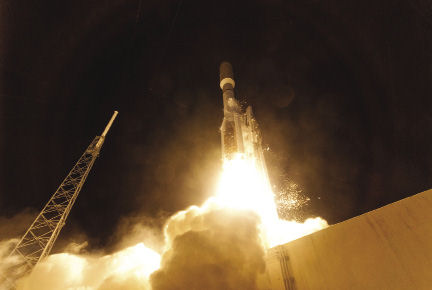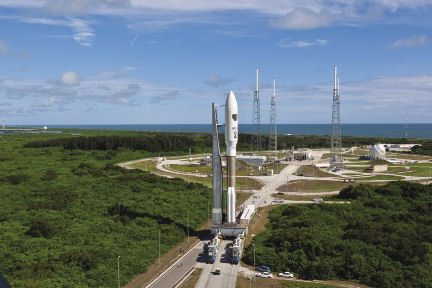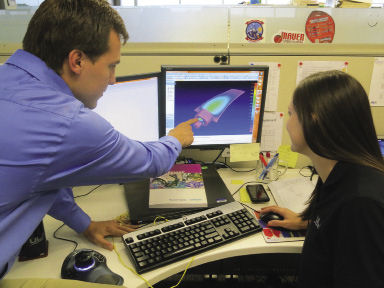Latest News
December 1, 2013
 United Launch Alliance’s engineering workflow is designed to minimize human error via automation. |
That culture is bound to test the massive data-and-process consolidation initiative at ULA.
As the science of rocket building gets more sophisticated, the types of analysis and simulation possible to predict and perfect the rocket’s performance also grow. “What is necessary to ]analyze a rocket] evolved over time,” says Marc Solomon, ULA’s PLM chief engineer and engineering systems architect. “We kept saying, ‘Let’s go try this’ or ‘Let’s make sure this doesn’t happen.’ We’re constantly learning. So we end up where we are today—hundreds of tools, and a chain of analysis in multiple steps, each one feeding into the next.”
It wouldn’t surprise anyone that ULA relies on digital simulation using industry-accepted CAE software to verify the integrity of its product concepts. But what’s lesser known is its reliance on non-geometric analysis. Solomon describes them as large-scale calculations related to “mass, moments of inertia, control dynamics, and angle of attack, for example.” These are, he says, “non-geometric analysis parameters that affect the basic plan of flight.”
ULA’s ambitious plan is to bring hundreds of simulation tools—a mix of homegrown, commercial and hybrid codes—under a single environment. As its data-management hub, ULA chose Siemens PLM Software’s Teamcenter. Solomon predicts that the team will “probably learn more about ourselves than we do about Teamcenter” in the process.
The Data Mound
In the past, ULA had to cope with disconnected systems and manual processes. To keep product development from different disciplines in sync, the staff resorted to labor-intensive data re-entry.
“How we melded data was measured in meetings and meeting time,” Gass explains. “It was brute force to get everyone to share More Information and check through the data to verify an analysis translated to a physical design. To have the most up-to-date data, we relied on manual processes—and obviously that led to errors.”
The data syncing difficulty was made more complex by ULA’s use of multi-disciplinary optimization (MDO), an approach in which various simulation and analysis tasks undertaken by different departments must come together.
“Our designs are essentially larger than their parts,” explains Solomon. “In most cases, we’re analyzing a large chunk of the system or the whole thing. It seems the rest of the world is focused on design management. That’s not enough for us. We must manage our design, but the world we work in demands a comprehensive engineering approach.”
Because ULA is one of a handful of companies building rockets, the company had to develop in-house tools to tackle the tasks commercial software couldn’t address.
“In the rocket world, there aren’t too many things you can buy off the shelf,” Solomon quips. “We use lots of commercial tools, tools we’ve developed in-house, and hybrid tools that have home-developed extensions on commercial tools. A big part of our Teamcenter integration is looking at how to integrate our non-commercial software tools.”
Big Bang Not Recommended
Like any large institution, ULA has built up the equivalent of muscle memory in its processes over the years. To persuade its staff to abandon the familiar routines, even for more efficient ones, wouldn’t be easy.
 ULA measures launch success by its analysis work, even more so than its design work. |
“I knew it was going to be hard, and it continues to be hard from the social perspective,” Solomon admits.
If the current system isn’t broken, why fix it? “We also wanted to break the mold of being tied to our roots to go on to doing something new,” Gass says, adding that he also recognized change is not ULA’s forte. Thus, he hedged on an incremental deployment strategy: Instead of the all-at-once Big Bang approach, which would have likely been disruptive and resistance-prone, the company launched a pilot program that would serve as a template.
As its first priority, ULA singled out requirements and analytical systems, the sectors that involve a high number of homegrown tools with different characters.
 ULA is integrating its simulation tools via Siemens PLM Software’s Teamcenter. |
“Every ]launch] mission has its own series of analyses,” Gass says. “Not only do we manufacture the rocket, but we also manufacture the mission design, and our ability to predict and model the mission, and deliver it to customers so they can use it, is critical.”
Gass had another reason for starting with analysis: Simulation analysts comprised the biggest skeptics who believed they could do everything themselves. At the same time, he also recognized they had the skills to embrace a project of this magnitude. Getting early buy-in from this group, then, would set the tone for the rest of the enterprise.
“We’re at the beginning stage. We’ve done all the homework. We’ve built the railroad tracks ]for integration],” he says. “So as we move from group to group, we don’t need to start all over. We pick a solution of ours, figure out the manner in which we’d like to integrate it, capture that very quickly, and then move on to the next group. It’s important to do this on an incremental basis, because we cannot destabilize the business as we move ]our tools] into Teamcenter.”
Laying Down the Tracks for the Future
When fully implemented, ULA’s Teamcenter deployment will oversee a mix of intertwining analysis activities, spanning from stability calculations in MathWorks MATLAB to structural analyses in Siemens’ NX CAE. The success of the implementation might be difficult to quantify, but Solomon has a specific yardstick in mind: “We want to see radical improvement in our ability to move More Information through the business.”
There is also the issue of the retiring workforce. ULA’s current simulation expertise is confined to a small group, a “special tribe.” Therefore, in Gass’ words, “the transfer of tribal knowledge to the next generation and ]to] do so as fast as possible using tools that appeal to the next-generation’s skill set” has taken on new urgency.
ULA runs two distinct rocket product lines, dubbed Atlas V and Delta IV. Each system, according to Solomon, has its own rich history and enterprise knowledge.
“In the process of integrating the two businesses, with lots of different ideas from each, we have to make sure we incorporate everything we know about each, and not lose any knowledge,” he explains. With Teamcenter as its consolidated data and process hub, he says, ULA hopes to retain its institutional wisdom.
ULA engineers are used to relying on a rigorous checklist of questions to conduct their analyses. The data from the checklists will now be mapped into Teamcenter, so most handoffs are automated, with a series of dashboards that reveal hiccups.
The most immediate benefit from the project so far, Solomon observes, is a “reduction in overhead of documenting analysis assumptions, processes and outputs. These tasks used to be repetitive manual data-entry tasks; today, they’re to be captured by the system.” As a consequence, Solomon points out, “someone downstream should be able to follow a chain of analysis all the way back to the start, so he or she can confirm or challenge the assumptions.”
Another advantage introduced by Teamcenter is easier change management in the analysis chain.
“]Engineering] assumptions cascade through one group to the next,” Solomon says. “If there’s a change, new assumptions move downstream. So whenever there’s a change injected into the process, the groups have to reassess the assumptions.”
With manual data entry, there was always a risk that altered assumptions might not properly be communicated to the rest of the analysis tree. The automated process ensures changes are flagged with alerts, along with dashboards providing a transparent view of how the change affects the rest of the operations.
“We tend to be overly cautious, because our mistakes are highly visible,” Solomon notes. “If we don’t truly understand a change’s impact, we might possibly—and certainly have in the past—redo the work we’ve done, just to be sure. If we understand the changes, we save cycles by reducing—in classic Lean manufacturing terms—overproduction.”
Hands-free Flight
Even among devout fans of rocket science, there may be a common misconception that unmanned rockets launched into space are meticulously shepherded by a team at Mission Control, perhaps using a sophisticated steering device to drive them through asteroid fields like you might do in a video game. But that is not the case, Solomon says.
“The launch vehicles are truly autonomous,” he explains. “When we designed them, we gave them structure, capability and power. We also gave them autopilot. We tell them, ‘Your job is to get from here to there. Whatever you may encounter in space, your job is to get this ]payload] to this point and drop it off without breaking it.’ At a certain point, we say goodbye to them; they’re on their own. There’s nobody with a joystick driving them.”
To be able to travel through space autonomously, the rocket’s internal infrastructure must facilitate automatic flight data assessment, with no manual intervention from Mission Control. There’s a certain parallel to this hands-free approach to be found in what ULA has set out to accomplish with Teamcenter.
“We’re not research scientists tackling open-ended questions. We’re trying to solve engineering problems within set schedules and costs,” Solomon concludes. “We want to let our engineers be part of an integrated system that stays in lockstep with the business, but we don’t want to tell them how to do analysis.”
Gass echoed the sentiment while talking about the project at Siemens’ analyst event in September: “It’s all about winning the hearts and minds of people. Introducing Teamcenter is more about people change management than about IT connectivity.”
Kenneth Wong is Desktop Engineering’s resident blogger and senior editor. Email him at [email protected] or share your thoughts on this article at deskeng.com/facebook. Additional reporting by Desktop Engineering Contributing Editor Beth Stackpole.
More Info
Subscribe to our FREE magazine, FREE email newsletters or both!
Latest News
About the Author
Kenneth Wong is Digital Engineering’s resident blogger and senior editor. Email him at [email protected] or share your thoughts on this article at digitaleng.news/facebook.
Follow DE





